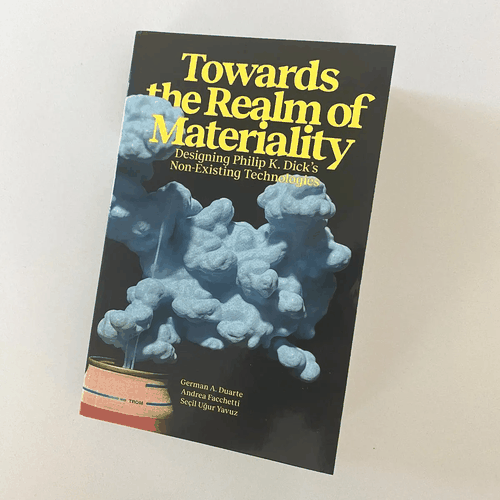
This new book Towards the Realm of Materiality: Designing Philip K. Dick’s Non-Existing Technologies came at just the right time.
I can perhaps best describe it as a collection of essays and project documentation taking as a basis the very active, prolific and audacious imagination of Philip K. Dick — and translating what is seen, felt, described in his various novelistic science-fiction worlds into speculative material forms. Which is an incredibly cool conceit. It feels very Design Fiction, as if PKD’s science-fiction were specifications for things that were items of necessity, convenience, or entertainment.
Imagine giving a consumer electronics company executive a copy of VALIS or Ubik and saying:
“Your design brief is between pages 16-48, but I recommend reading this cover to cover..I’d like to manufacture the artifact on page 24 at scale..so I’ll need 1,000 units in 9 months to do some test marketing and consumer studies..how much for that? Can we get started straight away?”
Man, I’d love to live in that world where you could write a story as a design brief.
I’m not talking about those canned, flat, unresponsive ‘user scenario’. I’m talking about something far more complete, imaginative, and unexpected. Or suppose you could hand someone a newspaper or magazine or even a product catalog as a brief. You’d have something that was full of all these curious (as curious as the meandering, peculiar, bewilderingly evocative things that you find on Alibaba) artifacts that imply the circumstances of the world — the hopes, fears, dreams, dreads, and desires, all complex and multiple and impossible to single out as if we all hope, fear, dream, dread and desire the same thing.
I’ve mentioned this before, but back in the day when I was in grad school the first time I worked as a research assistant at the HITLab — the Human Interface Technology Lab — at the University of Washington, Seattle. I did that because that was one of maybe two or three places in the US at the time that was doing any serious work on Virtual Reality (the first edition, back in the mid-1990s) and all I really wanted to do was experience VR.
At the time, you needed two incredibly expensive SGI ‘RealityEngine’-based workstations, one for each eyeball — and they cost, like..an eyeball watering $400k per eyeball, if memory serves. And those were 1995 dollars! And then you need Jaron Lanier’s VPL rig which was the vanguard of VR hardware. All so you could see a few geometric primatives floating in space — and that was inspired stuff. I mean — I travelled all the way across the USA by car and talked my way into a job there all so I could try it out. No grift, I was sincere and earnest and this felt like where Imagination could thrive trying to wonder into a possible world in which VR was the next wheels on luggage inspired innovative thing.
I asked one of the fellers in the lab — a guy who went by the moniker ‘Random’ (a/k/a Phillip Reay) where the lab handbook or manual was so I could figure out how to boot up this thing. He looked at me, grinned slightly — and told me to go down to the book shop in Pioneer Square and pick up a copy of Neuromancer. “That’s your lab handbook.”
That moment of interaction is something that is seared into my consciousness. I can still see Random looking at me with a smile. (We still talk about once a week in Office Hours!)
That moment may have been the first inkling of a thought that fiction and fact intermingle — and perhaps should do so more explicitly. This is a mindset that Design Fiction insists upon.
It feels like that same instinct and motivation is what motivates Towards the Realm of Materiality.
The book can live alongside of my collaboration with an OpenAI endpoint, Androids Dream of Electric Sheep. That particular Design Fiction artifact, materializing an adjacent entanglement of potential and possibility when we’ll have crappy mass market pulp paperback books by self-proclaimed machine intelligence gurus who will explain to you how to optimize the performance of your companion intelligence agents the way self-proclaimed human motivational gurus explain to you how to optimize the performance of your own psyche to attain peak attitude or comprehend the anxieties of your hormone manufacturing pubescent adolescent offspring who now finds you variously embarrassing/annoying/prying/stupid/etcetera (cf Inside Out, Inside Out 2, etcetera).
Every organized assemablage of human creative potential to produce value, also known today as a “Company” should find its way to imagine as expansively and thorougly as PKD somewhere, sometimes, perhaps routinely. The fact that his imaginings continue to capture, shape, influence, and resonate to the degree that they have, 60, 80 years beyond him putting ink on paper is incredible.
This is what I mean when I say, “It’s Time To Imagine Harder”.